Mykonos Town & Villages

Mykonos is an island of contrasts. An island where the picturesque goes hand in hand with a frenzy development, and natural beauty with the high society pages. But whichever way you look at it, one thing is certain: Mykonos is one of the most beautiful islands of the Aegean, and it offers the widest variety of holiday choices.
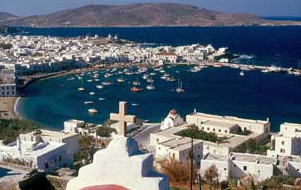
Hora
The most picturesque port in the Cyclades, it looks as though it just stepped out of a painting.
The stark white houses, with their parallel staircases and multicoloured doors, windows and banisters cling to the hill that rises toward the windmills. There are narrow streets paved with flagstones outlined in white. Over the roofs of the houses we can see the brightly painted domes of churches toped with the characteristic crosses. This is Mykonos Town.
In summertime life tends to focus on the central road through town, Matoyanni St. and the narrow lanes around it, collectively known as the Matoyannia districts, which constitute the commercial centre of the town. These few blocks of buildings contain shops, bars and restaurants to suit very taste and wallet. In fact Matoyanni St. is one of the priciest shopping streets in all Greece. Barkia is a crowded and noisy place of the Mykonos town, which is youthful in tone and full of life, music and street artists. You can buy colored bracelets and dancing toys, or have yourself tattooed with henna.
Just before the Town Hall stand the marble slabs where the fishermen set out their catch in the early morning. It is around here that you are likely to see Petros the Pelican, one of the Mykonos's trademarks.
Little Venice, on he right-hand side of the Aleskandra Bay, is built on foundations resting in the sea- hence its name. In the afternoon, when they have their last swim, hundreds of young people-and some not so young - press onto the balconies and low walls of the shops to watch the sun turn the sea red.
After Little Venice, there is Praportiani Church. It takes its name from the location close to the small gateway in the medieval fortification. An important historical and cultural monument during the day, at night Paraportiani becomes a "crusing spot" for gays, where absolutely anything can happen.
Mando's Square, with the statue of Mando Maurogenous, a heroine of the Greek War of Independence, standing next to the taxi stand.
At Lakka there is an open-air theatre which in summer is used for concerts and other events. Movie-lovers will be delighted by the Mando Open-Air Cinema, located in a beautiful garden behind the Catholic Church and regarded as one of the most attractive open-air summer cinemas in Greece.
Note that parking and traffic are heavy problems during summertime.
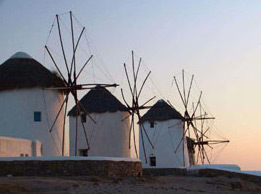
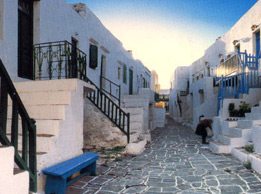
Ano Mera
Ano Mera, the second traditional settlement of the island after Hora, was established in 1571 by Cretan settlers who had previously lived for a couple of years on the island of Folegandros. Located on the eastern part of Mykonos, Ano Mera is where most of the island's permanent inhabitants now have their homes. The settlement is organized around the historical monastery of Virgin Mary the Tourliani, where the island's biggest festival is held on 15th August (Assumption of Virgin).
Every Sunday there is a lot of activity in the village square after the service in the adjacent Covent, especially in the summer, when the so called Anomerites (people whose origin is from Ano Mera) from Athens are on holiday on the island. In tourist terms the town is not particularly developed, however in the summer of 2001 something changed. The reformation of the village square that was made into a pedestrian area has totally transformed the village. This change, combined with the new tendency of many visitors to avoid Hora on their evenings out, along with the opening of Dafni, have lead many people to this direction. Ano Mera has acquired a new persona.
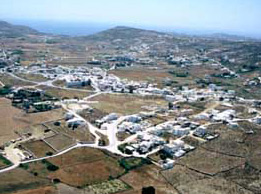
Platys Gialos
The village built around the beach with the same name, a hive of activity in the summer months. The landscape is impressive, the cape with the hill being the most prominent, protecting the bay well from the south-eastern winds. It is an area of intense activity with all the advantages and disadvantages that this entails.
There are numerous hotels and complexes of rental rooms (more than 25), as well as shops, but in the winter the place is much quieter. Just outside Platys Gialos , at Lino, you can see the remains of Hellenistic and Roman fortifications and at Portes, you should note the three granite stones, which made up the gateway to a tower of the sae fortifications.
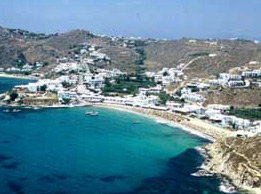
Aghios Stefanos
Virtually Aghios Stefanos has become a new suburb. Located around the homonymous beach (3km north from Hora) looking to the west, took its name from the little church on the shore. Aghios Stefanos and its neighbouring Tourlos and Houlakia have undergone considerable development recently.
Since it is among the first areas outside Hora that attracts regular summer visitors it is home for more than twenty hotels and complexes. Many Athenians have bought or rented houses in Houlakia and the area above Aghios Stefanos due to the view, which is breathtaking (one can see the islands around Tinos, Syros, Rinia etc).
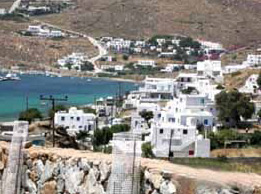
Ornos
Ornos is built around the beach with the same name, popular due to the protection it offers from the wind. Along with Aghios Ioannis Ornos beach has developed in an almost compound and autonomous tourist settlement. The buildings are new, but adapted to the traditional Cycladic architecture. There are rental rooms hotels (many of them luxurious) and a great deal of activity in the summer, but in the winter the village has no more than 300 permanent inhabitants.
Ornos is located in the end of the ring road which begins from Tourlos, north of the City of Mykonos (Hora). This is where the recently renovated municipal Sports Field and the factory of Desalination are. Just outside Ornos lies the district of Kanalia, which has undergone considerable development in the last few years, with the building of luxury residential complexes and villas owned by prominent Greek business figures. Kanalia is laid out in the form of an amphitheatre on a hill outside Hora.
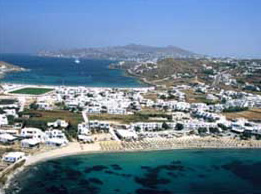
Ai-Yiannis
This is a small traditional village of local character, built amphiteatrically around the beach of Ai-Yiannis. The village is full of life and activity in the summer, its luxury hotels swarming with the guests, but is almost deserted in the winter months.






